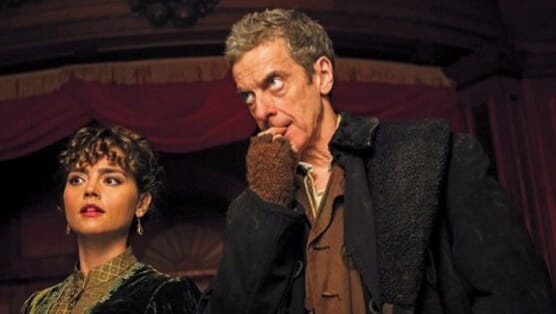Doctor Who: “Deep Breath”
(Episode 8.01)

Doctor Who is back! And with it comes the wonderful prospect of a new Doctor. In this case, we are finally able to witness Peter Capaldi’s take on the famed Timelord. And while the beefed up, 75-minute episode may not be the most mind-blowing of head writer Steven Moffat’s Who scripts, it’s pedestrian nature does manage to squeeze some memorable moments from its formulaic structure.
In true Who fashion, the first shot opens with a wonderfully bizarre juxtaposition— a T-Rex in the middle of Victorian-era London. The creature is soon quickly contained by the Paternoter Gang (Madame Vastra, Jenny and Strax), but not before spitting up a very familiar blue police box. Inside, we find a disheveled Clara and the new Doctor, still reeling from the effects of his regeneration.
As The Doctor’s new personality is still settling, he finds himself hearing and understanding the anguished cries of the confused dinosaur. Before our favorite Time Lord is able to do anything, however, the creature suddenly bursts into flames. According to the Vastra, death by spontaneous combustion has been shockingly common as of late. The Doctor goes off on his own while Clara and the team look for clues. Suddenly, Clara’s eye is caught by an ad in the paper addressed to one “Impossible Girl,” the previous Doctor’s nickname for her. Believing it’s a message, she eventually finds herself at a restaurant where the Doctor meets her. It turns out, he didn’t send the message either.
The two quickly discover that the restaurant is far more malevolent than they predicted. The patrons are all robots with Ed-Gein-esque skin faces (given the implications, I’m fairly shocked the show can be so light about this macabre development). What’s more, The Doctor and Clara quickly find themselves in the bottom of the restaurant, which turns out to be a spaceship. The robot leader is a man who looks mostly human, save for the Two-Face chunk of his face that reveals the metallic mechanisms beneath.
At first glance, when the lead robot is seen abducting a man from his eye from an earlier scene, I suspected him of being some kind of relative to the robot antagonist from last year’s “A Town Called Panic.” As evidenced by the clock-like whirring sounds that accompanied the robot’s movements, however, any diehard Whovian could no doubt quickly make a connection to similar robots from the much-celebrated second season entry “The Girl in the Fireplace,” which served as one of Steven Moffat’s earlier, fan-favorite entries to the series. This time around, Moffat has given his creations a kind of reverse Cybermen motivations. Rather than trying to convert humans into robots, the lead robot is instead trying to turn robots into humans, by using body parts and skin from all the Londoners who “died” of spontaneous combustion (including, the dinosaur).
The Paternoster Gang arrive just in time to save The Doctor and Clara from having their bodies stripped for parts, but they seem woefully outnumbered by the battle-ready androids. As the team fights, The Doctor has a more intimate face-to-face confrontation with the leader who has the ship below the restaurant rise above the city. Perhaps due to him now being more human than robot, the leader has developed a kind of religious faith. He believes that soon he will be able to enter a kind of Heaven (or “Promised Land”) in the sky. The Doctor points down to the city below, and gives the robot an ultimatum—either he destroys himself, or The Doctor will be forced to murder him to protect the human race. Just as Clara and the others appear to be losing the fight, we see the robot fall from the sky, ending up impaled on the top of Big Ben. In a bit that’s unfortunately reminiscent of the climaxes of Phantom Menace and The Avengers, all of the robots are quickly de-powered.
Shortly after, The Doctor and Clara take off back to modern times in the TARDIS. At first, Clara seems hesitant about continuing on with The Doctor. A surprise phone call from Matt Smith’s Eleventh Doctor, however, puts her at ease, and she lovingly accompanies the new Doctor down the streets of Glasgow. Given his newfound Scottish accent, he should feel right at home.
-

-

-

-

-

-

-

-

-

-

-

-

-

-

-

-

-

-

-

-

-

-

-

-

-

-

-

-

-

-

-

-

-

-

-

-

-

-

-

-








































